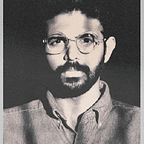NFTs, Art, and the Future of Digital Identity
Art as Identity — The First NFT Use Case
The crypto world came into my radar a few years ago but it was the spectacle of Beeple’s NFT that really drew me in. Since then, I have spent a considerable amount of time reading and learning about this new digital infrastructure being created in front of us. Raoul Pal, a former hedge fund manager, macro thinker, and thought leader in the crypto space, talks about this idea of a ‘great-migration’ taking place with millions of humans moving further into the digital sphere. I think this is an interesting way to frame the significance of the moment and a great metaphor to use to symbolize the shift taking place right now. There is a huge amount of distrust in large entities, be it corporations or nation-states and their inability to manage the world’s digital, financial, and cultural systems that it’s fueling the search for an alternative decentralized structure.
What I am interested in is the cultural phenomenon of NFTs and how this may influence the way we produce and consume art from here on out and more specifically how this could tie into the future of digital identity. We are already seeing how NFT avatar projects or ‘PFPs’ from CryptoPunks, Bored Ape Yacht Club, to independent projects like Amrit Pal Singh’s Toy Faces are offering different value propositions to people as unique collectables and digital art. What seems to be common across digital culture today is that the owner of the NFT often displays them as their profile picture on social media. The circular placeholders once meant to reveal your identity have been replaced by ‘digital avatars’. Art as Identity seems to be the 1st use case for NFTs.
My observation is that NFTs are a natural evolution of digital culture, which empowers art to serve a functional purpose in our society beyond a pure aesthetic pursuit. For example, while the Internet gave us unlimited access to knowledge and human connectivity across the world, it also created a system where we lost control of our identity and actions. It nurtured a culture of exploitation where our lives became perpetual streams of data monetized for private gains. In essence, we became the raw material for centralized power. There was bound to be a reaction to this system and a natural evolution of the Internet where we see a reversal of power and a move towards a more decentralized peer-to-peer connection. This is where I feel NFT’s could fall into place. It seems almost over night that digital assets went from being unlimited in supply and ambiguous to extremely scarce with clear ownership properties. The question then becomes what kinds of digital assets can be empowered by NFTs? I presume almost everything can and will be tokenized.
Perhaps in this future all our online actions neatly fold into a special ‘identity and actions NFT’, which if companies like Google or Facebook want to access, have to pay in some way or the other. In other words, NFTs enable us to own our digital presence and therefore be able to monetarily gain from being used.
A NFT can therefore be an art object and serve a functional purpose in our society at the same time — It can give you aesthetic pleasure, protect your identity, and can be carried with you wherever you go. In this future, wouldn’t you want to own your own identity?
‘Everything That Disappears Leaves a Trace’
As a response to this, I developed a project that transforms your digital portrait into a unique six second moving image NFT, which I then gift back to you for free. It began as a participatory experiment to explore the future of art and identity by first generating a NFT based on your portrait with the anticipation that as we migrate into the future, this could directly be tied to your digital identity. It then evolved into a way to also depict this idea of “the great human migration” taking place from the real to the digital, so I began ‘melting’ portraits of people who were present or born after January 1, 1983, the official birth of the modern Internet. We are living through the beginning of a shift in human consciousness that began at this time and now blockchain technology is leading our society through a second wave of migration that will take us even deeper into the digital realm. My aim is to capture the genesis of this next phase in human evolution by using NFTs as the medium for this body of work.
For those who already own NFTs, this could form a unique self-portrait with a story and a future use-case added to your digital art collection and for those who have never owned a NFT, this could act as your gateway into crypto culture.
To learn more about the project and how you can get your own NFT minted, click here.
*This essay was originally published on 1:11 Journal
About Harsha Bis:
Harsha Biswajit is a new media visual artist currently living and working in Berlin. His work primarily explores transformations brought about by technology. Before he entered the world of art, he was once dabbling with economics before deciding to make the dive as a full time artist in 2010.
You can find him on:
